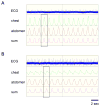Respiratory assessment in centronuclear myopathies
- PMID: 24668768
- PMCID: PMC4140950
- DOI: 10.1002/mus.24249
Respiratory assessment in centronuclear myopathies
Abstract
The centronuclear myopathies (CNMs) are a group of inherited neuromuscular disorders classified as congenital myopathies. While several causative genes have been identified, some patients do not harbor any of the currently known mutations. These diverse disorders have common histological features, which include a high proportion of centrally nucleated muscle fibers, and clinical attributes of muscle weakness and respiratory insufficiency. Respiratory problems in CNMs may manifest initially during sleep, but daytime symptoms, ineffective airway clearance, and hypoventilation predominate as more severe respiratory muscle dysfunction evolves. Respiratory muscle capacity can be evaluated using a variety of clinical tests selected with consideration for the age and baseline motor function of the patient. Similar clinical tests of respiratory function can also be incorporated into preclinical CNM canine models to offer insight for clinical trials. Because respiratory problems account for significant morbidity in patients, routine assessments of respiratory muscle function are discussed.
Keywords: canine; genetics; muscle disease; myopathy; respiratory assessment.
© 2014 Wiley Periodicals, Inc.
Figures




Similar articles
-
Clinical, Electrophysiology, and Pathology Features of Dynamin Centronuclear Myopathy: A Case Report and Review of Literature.J Clin Neuromuscul Dis. 2016 Dec;18(2):84-88. doi: 10.1097/CND.0000000000000141. J Clin Neuromuscul Dis. 2016. PMID: 27861221 Review.
-
Respiratory motor function in individuals with centronuclear myopathies.Muscle Nerve. 2016 Feb;53(2):214-21. doi: 10.1002/mus.24899. Epub 2015 Dec 29. Muscle Nerve. 2016. PMID: 26351754 Free PMC article.
-
Respiratory features of centronuclear myopathy in the Netherlands.Neuromuscul Disord. 2023 Jul;33(7):580-588. doi: 10.1016/j.nmd.2023.06.003. Epub 2023 Jun 11. Neuromuscul Disord. 2023. PMID: 37364426
-
RYR1-Related Myopathies: Clinical, Histopathologic and Genetic Heterogeneity Among 17 Patients from a Portuguese Tertiary Centre.J Neuromuscul Dis. 2017;4(1):67-76. doi: 10.3233/JND-160199. J Neuromuscul Dis. 2017. PMID: 28269792
-
Inherited myopathies and muscular dystrophies.Semin Neurol. 2008 Apr;28(2):250-9. doi: 10.1055/s-2008-1062269. Semin Neurol. 2008. PMID: 18351526 Review.
Cited by
-
Diaphragm assessment in mice overexpressing phospholamban in slow-twitch type I muscle fibers.Brain Behav. 2016 Apr 22;6(6):e00470. doi: 10.1002/brb3.470. eCollection 2016 Jun. Brain Behav. 2016. PMID: 27134770 Free PMC article.
-
Gene therapy in monogenic congenital myopathies.Methods. 2016 Apr 15;99:91-8. doi: 10.1016/j.ymeth.2015.10.004. Epub 2015 Oct 14. Methods. 2016. PMID: 26454198 Free PMC article. Review.
References
-
- Sewry CA, Jimenez-Mallebrera C, Muntoni F. Congenital myopathies. Curr Opin Neurol. 2008;21(5):569–575. - PubMed
-
- Sharma MC, Jain D, Sarkar C, Goebel HH. Congenital myopathies--a comprehensive update of recent advancements. Acta Neurol Scand. 2009;119(5):281–292. - PubMed
-
- Romero NB. Centronuclear myopathies: a widening concept. Neuromuscul Disord. 2010;20(4):223–228. - PubMed
-
- Buj-Bello A, Biancalana V, Moutou C, Laporte J, Mandel JL. Identification of novel mutations in the MTM1 gene causing severe and mild forms of X-linked myotubular myopathy. Human mutation. 1999;14(4):320–325. - PubMed
Publication types
MeSH terms
Grants and funding
LinkOut - more resources
Full Text Sources
Other Literature Sources

